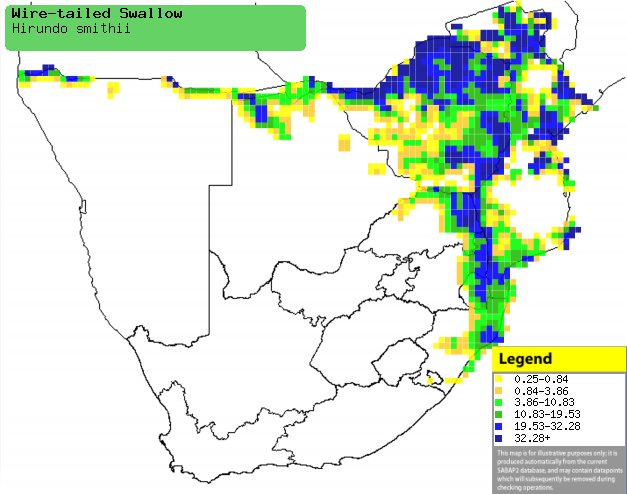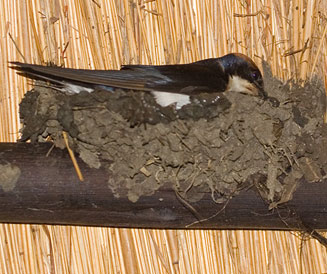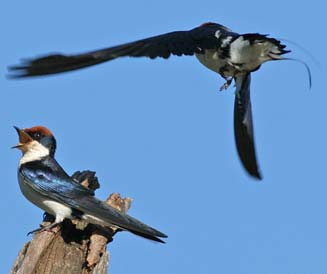|
Hirundo smithii (Wire-tailed
swallow)
Draadstertswael [Afrikaans]; iNkonjane (generic term for
swallows) [Zulu]; Sisampamema (generic term for swallows, martins, swifts and
spinetails) [Kwangali]; Nyenganyenga (generic name for swallow or martin)
[Shona]; Mbawulwana, Nyenga (generic term for swallow) [Tsonga]; Roodkruinzwaluw
[Dutch]; Hirondelle à longs brins [French]; Rotkappenschwalbe [German];
Andorinha-cauda-de-arame [Portuguese]
Life
> Eukaryotes >
Opisthokonta
> Metazoa (animals) >
Bilateria >
Deuterostomia > Chordata >
Craniata > Vertebrata (vertebrates) > Gnathostomata (jawed
vertebrates) > Teleostomi (teleost fish) > Osteichthyes (bony fish) > Class:
Sarcopterygii (lobe-finned
fish) > Stegocephalia (terrestrial
vertebrates) > Tetrapoda
(four-legged vertebrates) > Reptiliomorpha > Amniota >
Reptilia (reptiles) >
Romeriida > Diapsida > Archosauromorpha > Archosauria >
Dinosauria
(dinosaurs) > Saurischia > Theropoda (bipedal predatory dinosaurs) >
Coelurosauria > Maniraptora > Aves
(birds) >
Order: Passeriformes > Family: Hirundinidae
Distribution and habitat
Occurs across much of Asia and sub-Saharan Africa, absent
from the lowland forest of West Africa and the DRC. In southern Africa it is
locally common in the extreme north of Namibia, northern Botswana, Zimbabwe,
central and southern Mozambique, Swaziland and eastern Limpopo Province,
Mpumalanga and KwaZulu-Natal.
|
 |
|
Distribution of Wire-tailed swallow in southern
Africa, based on statistical smoothing of the records from first SA Bird
Atlas Project (©
Animal Demography unit, University of
Cape Town; smoothing by Birgit Erni and Francesca Little). Colours range
from dark blue (most common) through to yellow (least common).
See here for the latest distribution
from the SABAP2. |
Movements and migrations
Little known, but it is thought be resident
throughout its southern African range.
Food
Hawks aerial insects often in flocks with swallows, such as
Grey-rumped (Pseudhirundo
griseopyga) and Lesser striped (Hirundo
abyssinica) swallows. The following food items have been recorded
in its diet:
Breeding
- Monogamous, solitary nester, with the pair bond lasting for the whole
breeding season and probably for life.
- The nest (see image below) is built by both sexes in about a week,
consisting of a flat open cup built of mud pellets and lined with stems,
grass and feathers. It is typically placed in an artificial site, such as
near the roof of a veranda, on a wooden cross beam, inside a water tower,
under a bridge or even on a boat. The same site is used repeatedly over
multiple seasons; before laying the eggs the original structure is repaired
 |
 |
| Wire-tailed swallow at its nest,
South Africa. [photo
Neil Gray
©] |
Wire-tailed swallow pair in courtship display,
Tanzania. [photo Martin Goodey
©] |
- Egg-laying season is year-round, peaking from August-December and
February-April.
- It lays 2-4 eggs, which are incubated solely by the female for 14-19
days. In one study the eggs where incubated for 43-66% of the day.
- The chicks are brooded by the female for the first few days of their
lives after which the male sometimes helps out. They are fed regularly by
both sexes, leaving the nest after 15-24 days. The fledglings still roost in
the nest for at least 3-4 weeks, possibly until the next clutch is laid.
Threats
Not threatened, in fact its range has benefited from the
introduction of man-made nest sites.
References
-
Hockey PAR, Dean WRJ and Ryan PG 2005. Roberts
- Birds of southern Africa, VIIth ed. The Trustees of the John Voelcker
Bird Book Fund, Cape Town.
-
Harrison, J.A., Allan, D.G., Underhill, L.G., Herremans, M.,
Tree. A.J., Parker, V. & Brown, C.J. (eds). 1997. The atlas of southern
African birds. Vol. 2: Passerines. BirdLife South Africa, Johannesburg.
|
